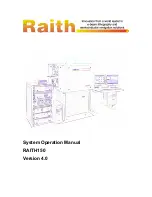
Clinical Use of the RNS
®
System
30
RNS
®
System User Manual
The leads to be implanted are selected based on the location of the seizure focus. NeuroPace
®
Cortical Strip Leads are recommended for seizure onsets on the surface of the cortex, where the
cortical strip leads may be placed over the focus. NeuroPace
®
Depth Leads are recommended for
seizure onsets beneath the cortical surface, such as within the mesial temporal lobe or within
subcortical lesions such as dysplasias, where the depth lead may be placed within the seizure focus.
Several lead lengths are available (refer to
the
NeuroPace® Cortical Strip Lead
section). The lead model selected should be the appropriate length to
reach from the seizure focus to the neurostimulator with as little excess lead as possible.
Up to four leads can be implanted (no more than two depth leads). For example, two depth leads and
two cortical strip leads, or one depth lead and three cortical strip leads could be implanted. Only two
leads can be connected to the neurostimulator at a given time; unconnected leads should be capped.
Leads connected to the neurostimulator can be changed at a subsequent procedure if desired.
P
ATIENT
T
RAINING
•
Prior to the implant surgery, train the patient and / or caregiver how to use the NeuroPace
®
Remote Monitor and wand, as well as how to use the magnet to mark clinical seizures.
•
After implantation, provide the patient with the medical implant identification card.
•
Instruct the patient and/or caregiver to interrogate the neurostimulator every day using the remote
monitor and wand, and to synchronize the remote monitor with the PDMS at least once a week
(preferably every day).
O
VERVIEW OF
I
MPLANTATION AND
P
ROGRAMMING OF THE
RNS
®
S
YSTEM
Implanting the RNS
®
Neurostimulator and Leads
The RNS
®
Neurostimulator is cranially implanted. A ferrule is secured to a full thickness craniectomy
and then the neurostimulator is placed within the ferrule. The recommended location of the
neurostimulator is in the parietal skull but this can be modified based on the location of the leads and
the curvature of the patient’s skull. The neurostimulator may be implanted and secured in the ferrule
before or after the leads are implanted. Instructions for implanting the RNS
®
Neurostimulator are
provided in the
Leads are placed using standard neurosurgical techniques. NeuroPace
®
Depth Leads may be
implanted using standard stereotactic techniques through a burr hole in the skull, then secured by a
burr hole cover such as the NeuroPace
®
Burr Hole Cover Model 8110. NeuroPace
®
Cortical Strip
Leads are implanted through a craniectomy, in a manner similar to standard strip lead placements,
then secured using suture sleeves. Leads are tunneled under the scalp to the craniectomy.
Instructions for implanting NeuroPace
®
Depth Leads and NeuroPace
®
Cortical Strip Leads are
provided in the
When the implantation procedure is complete and while still in the operating room, the programmer is
used to test lead impedances and to capture real-time ECoG to ensure that there is good lead-tissue
contact. Instructions for checking lead impedances and for real-time ECoG are provided in the
section and the section describing
Recommended Initial Detection and ECoG Storage Settings
The neurostimulator is initially programmed in the operating room to detect electrocorticographic
activity (ECoG) and to store ECoG segments.
A bipolar electrode montage is used for sensing. The sensing montage must be configured in a
bipolar manner. The recommended initial montage is to sense between neighboring contacts. For
















































